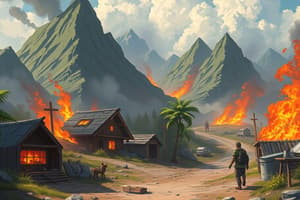Podcast
Questions and Answers
The Fire Triangle is a model for understanding the various ways of preventing fire and extinguishing fire.
The Fire Triangle is a model for understanding the various ways of preventing fire and extinguishing fire.
False (B)
Water is one of the elements of the Fire Triangle.
Water is one of the elements of the Fire Triangle.
False (B)
Oxygen is essential for combustion to occur.
Oxygen is essential for combustion to occur.
True (A)
Light is a necessary element for combustion to occur.
Light is a necessary element for combustion to occur.
Fuel is a reducing agent.
Fuel is a reducing agent.
Carbon dioxide is a gas that is released when there is smoke.
Carbon dioxide is a gas that is released when there is smoke.
A chemical reaction occurs when there is fire.
A chemical reaction occurs when there is fire.
The fire triangle is a model for understanding the causes of fire.
The fire triangle is a model for understanding the causes of fire.
A Fire Emergency and Evacuation Plan is a necessary safety measure for households.
A Fire Emergency and Evacuation Plan is a necessary safety measure for households.
Disaster Readiness and Risk Reduction is a topic only relevant to STEM students.
Disaster Readiness and Risk Reduction is a topic only relevant to STEM students.
Flashcards are hidden until you start studying
Study Notes
Fire Hazards
- Fire hazards include live flames, sparks, hot objects, and chemicals that can ignite or aggravate a fire, as well as potential threats to fire prevention, firefighting, and built-in fire safety systems.
- Fire hazards pose threats to life and property, and the primary object of safety systems is to detect, remove, or reduce these risks.
Elements of the Fire Triangle
- The fire triangle is a model that represents the three interdependent elements needed for fire: heat, fuel, and oxygen.
- Heat is necessary for the initial ignition of fire and its spread, and can be caused by various sources such as candles, stoves, and electrical appliances.
- Fuel is any combustible material, and its characteristics (moisture content, size, shape, quantity, and arrangement) affect its ability to burn.
- Oxygen is necessary for combustion to occur, and most fires require at least 16% oxygen content to burn.
Top Causes of Fire
- Cooking equipment is the leading cause of home structure fires and injuries.
- Smoking is the leading cause of civilian home fire deaths.
- Other common causes of fire include faulty wiring, kitchen stoves, smoking in bed, lighting, flammable liquids, candles, and children playing with fire.
Precautionary Measures
- Before a fire incident: have a disaster plan, ensure smoke alarms are installed and functional, keep household fire extinguishers handy, and make sure you can open windows, screens, security bars, and doors.
- During a fire incident: get to the nearest exit immediately, contact emergency services, and do not go back into a burning building.
- After a fire incident: wait for the fire department's instruction before re-entering your home, contact relevant agencies, collect valuable materials, and assess the damage.
NCCC Mall Fire Incident
- The NCCC Mall Fire incident on December 23, 2017, had a main cause and resulted in casualties (research required to identify the exact cause and casualties).
Studying That Suits You
Use AI to generate personalized quizzes and flashcards to suit your learning preferences.




